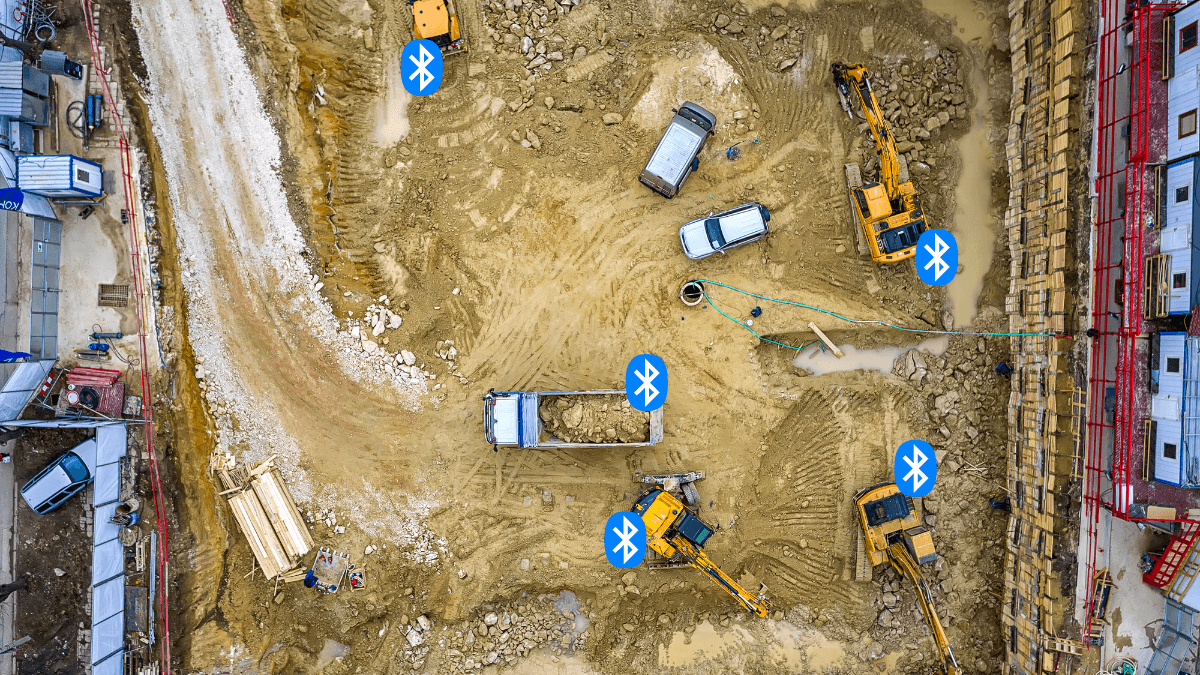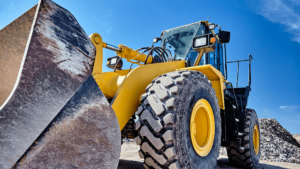It seems like Bluetooth beacons can be used to track anything nowadays, including construction assets like heavy equipment and tools and construction resources like workers and materials.
And that’s true, but—contrary to what’s often advertised—Bluetooth beacons have some downsides and limitations, which is why they’re often combined with other asset-tracking methods like GPS.
All this makes it challenging for construction companies to determine whether they need beacons, and what type.
That’s why we’ll introduce seven top construction asset tracking solutions involving Bluetooth beacons, explain how they work, and explore their practical applications.
In this article...
GoCodes Asset Tracking’ Bluetooth Beacons
GoCodes Asset Tracking’ Bluetooth beacons are primarily used as an extra security measure that complements the app’s core asset-tracking technology, namely GPS-enabled QR code tags.
When these technologies are combined, a construction company can efficiently track all assets, their locations, and users without resorting to more expensive, active GPS trackers.
To explain how GoCodes Asset Tracking accomplishes this, we’ll first look at its primary tracking method (QR codes) and then explain how Bluetooth beacons are utilized to enhance the overall tracking system.
GoCodes Asset Tracking uses patented rugged QR code tags that are attached to tools and equipment, and can be scanned with a smartphone or tablet (using the GoCodes Asset Tracking’ in-app scanner), all of which are shown below.

The biggest advantages of this QR code-based tracking technology are its simplicity, ease of implementation and use, and affordability.
Simply put, all you need to track the location and usage of your construction assets are (self-printed or pre-ordered/customized/delivered) QR code tags and the GoCodes Asset Tracking cloud-based app.
When installed on mobile devices like smartphones and tablets, the GoCodes Asset Tracking app (i.e., its in-app scanner) enables workers to scan a tagged asset with their device and access the asset’s info page.

Naturally, GoCodes Asset Tracking can be downloaded to other non-scanning devices like desktops and laptops, where users can search and locate tracked assets using the software’s central cloud database.
However, for asset-tracking purposes, it’s crucial that workers can use their phones to scan an asset when they’re taking it (check-out) and returning it (check-in).
This establishes a transparent chain of custody recorded by the software, increases worker accountability, and reduces theft.
Moreover, every time workers scan an asset, GoCodes Asset Tracking will record who scanned it and at what GPS location (using the mobile device’s GPS function) and show it on a Google map.

In short, the asset check-in/check-out function enabled by scannable QR code tags coupled with automatic GPS location updates allows you to know where all your assets are and who is responsible for them.
If an asset is stolen or lost, GoCodes Asset Tracking will provide the last known location and the responsible user, while the QR code label will serve as proof of ownership when the asset is found/retrieved.
Of course, this still doesn’t mean valuable equipment can’t be stolen from the construction site or “secure” storage.
And that’s where GoCodes Asset Tracking’ Bluetooth beacons come in.

These small, battery-powered devices use Bluetooth Low Energy (BLE) technology to transmit (and sometimes receive) short radio signals within a range of up to 300 feet (a little under 100 meters).
Those signals are detected by nearby mobile devices (smartphones, tablets) with the tracking app installed, and Bluetooth turned on.
When attached to high-value equipment located within a specific area (construction site or warehouse), BLE beacons enable workers to quickly find tracked assets obscured from sight and zero in on their location using the GoCodes Asset Tracking mobile app.
Moreover, the GoCodes Asset Tracking Guardian feature can turn one, two, or more smartphones into walking beacon detectors that alert you if an asset goes out of their range.

In practice, the Guardian app enables you to use one or more phones strategically positioned across the construction site, which then serve as stationary signal detectors that notify you if an asset moves out of their range.
Naturally, this enables you to take appropriate actions and investigate the matter.
When coupled with the GoCodes Asset Tracking’ core GPS QR code tracking method and check-in/check-out feature, Bluetooth beacons provide an additional layer of jobsite security.
What distinguishes the GoCodes Asset Tracking tracking solution from others described here is the ease of implementation of both QR codes and beacons and the cost-effectiveness of the entire tracking system.
Simply put, QR codes are low-cost, Bluetooth beacons are affordable, and the GoCodes Asset Tracking app operates on devices you already have, which makes it one of the most practical and affordable all-in-one asset-tracking solutions on the market.
ELA Innovation’s Bluetooth Beacons
ELA Innovation, a French company, has been developing wireless industrial beacons and sensors for over 20 years.
As such, their beacons are designed for different construction applications, such as site access control, geolocation of workers on a construction site, and, naturally, tracking of construction assets.
As for real-time tracking of worksite tools and equipment, ELA Innovation offers three Bluetooth-based solutions you can see highlighted below.

We already explained how the classic BLE tracking solution using mobile devices works, but ELA Innovation’s hardware may also include other types of BLE signal receivers (PCs, GPS boxes, and gateways).
For instance, stationary BLE receivers (gateways) can be strategically positioned across the construction site or warehouse to detect the presence of nearby assets and relay that info to the central tracking system.
This improves the accuracy and coverage of asset tracking compared to using just mobile devices but also raises the price and makes implementation more complex.
ELA Innovation’s other asset-tracking setup, Wirepas Mesh, involves a network of mobile beacons (tags) attached to assets and fixed beacons (anchors) positioned at regular intervals in the warehouse or on existing structures on the site.
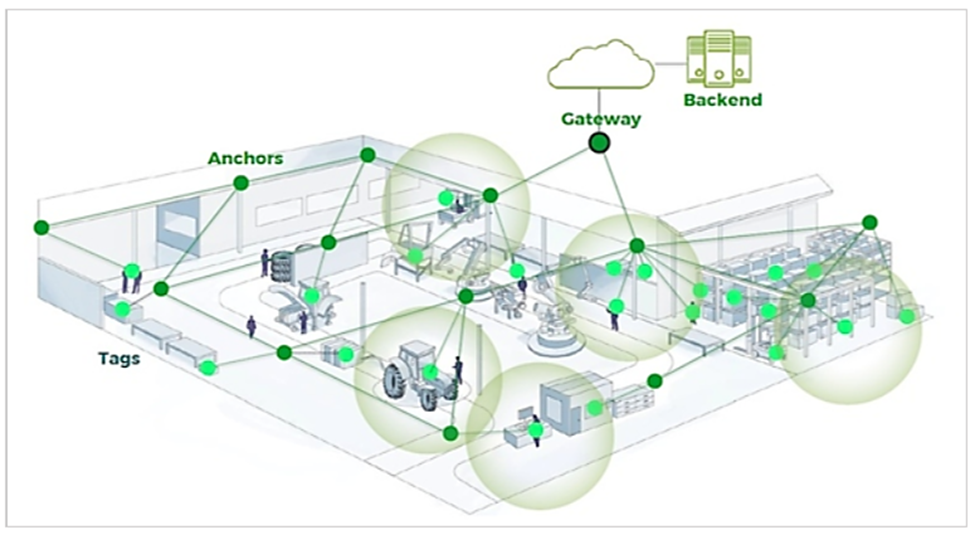
All these signals create a mesh that allows the Wirepas positioning app to transform that data into GPS coordinates and show the asset’s location to users.
Depending on the network’s density (number of fixed beacons), assets can be accurately localized within 15-30 ft (5-10 meters).
Their third tracking option, Quuppa AOA, is a high-precision indoor localization technique used to find assets within a warehouse with an accuracy of less than 3 ft (1 meter).
It uses mobile beacons on tools, equipment, and materials and fixed antennas installed at a height to receive beacon signals.
It is important to note that both Wirepas and AOA (Angle-of-Arrival) tracking technologies can use BLE radio frequencies as well as other wireless communication protocols.
Finally, ELA Innovation will provide essential software to manage your asset tracking, namely the BLE Gateway Web App and Device Manager Suite, or you can integrate their beacons into your own or third-party tracking software systems.
Overall, ELA Innovation’s Bluetooth beacons are extremely versatile, and you can choose the tracking setup that best fits your company’s needs.
Geotab’s Bluetooth Beacons
Geotab’s Bluetooth beacons are primarily designed to work in conjunction with the Geotab GO device and its telematics platform.
In other words, Geotab focuses on construction fleet management and active GPS tracking (GO devices) while using sensor-equipped BLE beacons to capture additional information beyond what the vehicle/equipment’s onboard systems provide.
For example, sensor-enabled beacons can monitor temperature and humidity (important for harsh construction environments), acceleration, impact, light exposure (important for detecting unauthorized movement or handling of assets), or even air quality.
In any case, Geotab GO devices (active GPS trackers) can be equipped with an IOX-BT add-on (physical adapter) which, when plugged in, turns these devices into Bluetooth signal receivers.
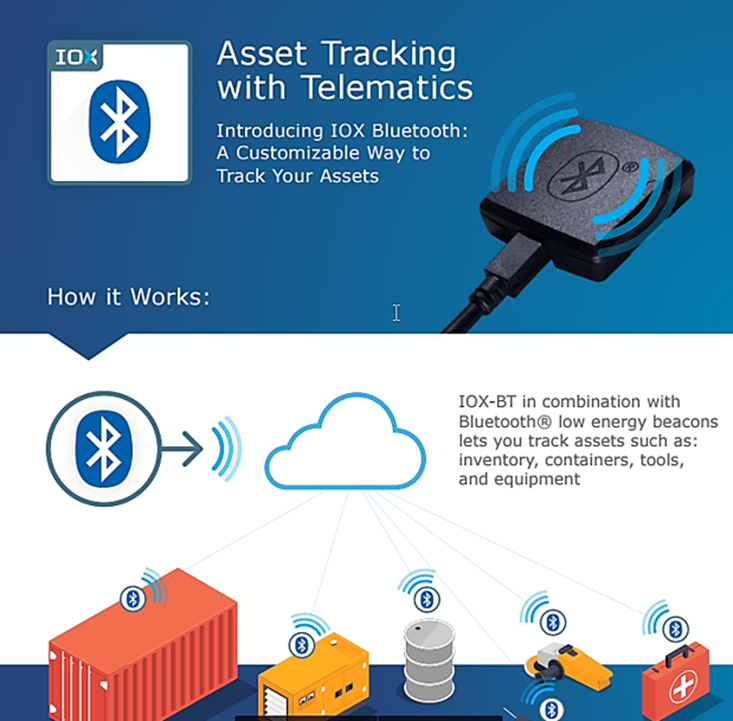
This enables each Geotab GO device to sense and monitor up to 200 beacons within its signal detection range.
In other words, you can use GPS tracking GO devices installed on your heavy equipment and vehicles to detect their sensor-enabled beacons and track other smaller assets shown above.
Depending on the number of GO devices on-site, this can enable you to monitor the location of all beacon-wearing, typically smaller construction assets, with the help of Geotab’s tracking software.

One advantage of GO devices with IOX-BT adapters is that they will detect any beacons with a public MAC address (part of each beacon’s unique identifier).
This means you can extend Geotab’s Bluetooth tracking solution with beacons purchased from other providers.
Again, Geotab is primarily a fleet tracking platform that utilizes active GPS trackers (Geotab GO devices) and Geotab cloud software to provide real-time location tracking and telematics data for vehicles and heavy equipment.
However, with their BLE signal-receiving adapter, GO devices can also detect nearby construction assets equipped with Bluetooth beacons, allowing companies to optimize asset utilization, minimize equipment loss and theft, and reduce costs.
MOKOBlue’s Bluetooth Beacons
The company MOKO (i.e., its Bluetooth IoT business unit MOKOBlue) focuses on providing the hardware components (beacons, gateways, etc.) necessary to establish a BLE-based asset tracking system.
In other words, rather than offering specialized asset-tracking software to go with their beacons, this Chinese company helps businesses develop their applications or integrate the beacons into existing software solutions.
Therefore, MOKOBlue will deliver Bluetooth beacons customized to your company’s preferences (brand logo, custom enclosure color, firmware, etc.) and, if needed, support it in creating its own asset-tracking solution.

MOKOBlue will do so by providing Software Development Kits (SDKs) or Application Programming Interfaces (APIs) as well as a range of other product development services.
As for their Bluetooth beacons, they can be used in various construction applications, such as site access control and security, fleet management, or monitoring on-site environmental conditions.
Naturally, they can also be used to track equipment and personnel and monitor the status of heavy machinery.
Here’s how MOKOBlue presents these potential beacon technology applications.
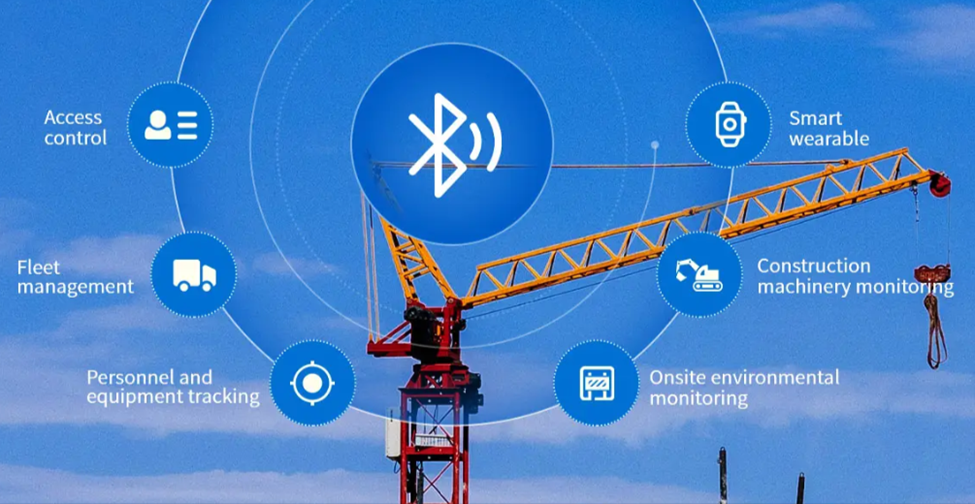
As expected, such diverse applications can provide construction companies with the tools needed to establish asset-tracking solutions that best fit their needs.
As mentioned above, companies that want to utilize MOKOBlue’s beacons would typically need to develop or use their own software or partner with a software provider specializing in asset tracking.
Therefore, unlike other beacon-based solutions that provide complete hardware/software packages, MOKOBlue’s beacons are best suited for building a new or expanding an already existing asset-tracking solution.
Teltonika Telematics’ Bluetooth Beacons
Teltonika Telematics is a European company (Lithuania) with a worldwide presence specializing in developing and manufacturing advanced telematics solutions, products, and accessories for efficient fleet management.
In other words, they provide hardware devices, such as active GPS trackers and Bluetooth beacons, and a software platform and applications for tracking and managing construction fleets and assets.
Similar to Geotab’s solution, their beacon-based asset tracking system takes advantage of GPS trackers installed on vehicles and heavy machinery to monitor their movement, usage, and other parameters.
These trackers, such as Teltonika FMB202, are simultaneously used to read and identify Bluetooth beacons in their proximity.
Each tracker can detect up to 100 Teltonika’s Eye beacons.
Here’s how this GPS/Bluetooth tracking system works.
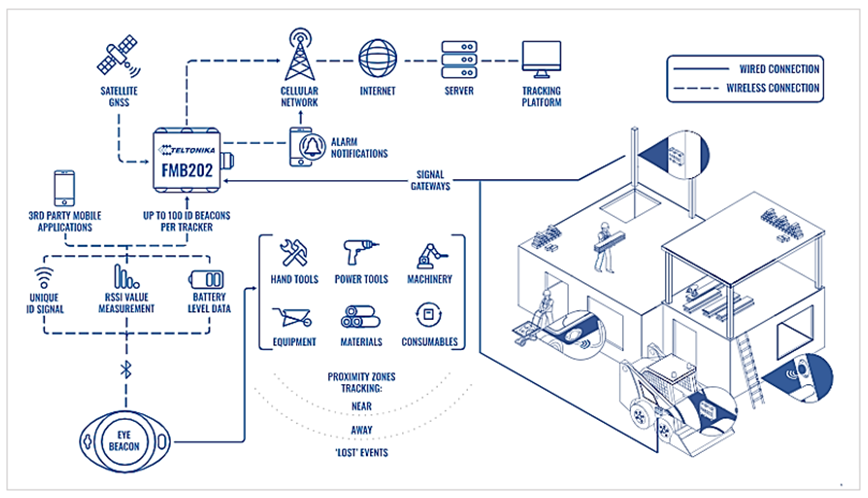
Long story short, GPS trackers (installed on vehicles and/or mounted on structures on the site itself) will pick up Eye beacon signals and route them to the tracking app that will turn this data into real-time asset location updates.
Although Teltonika’s Eye beacons are designed to work in conjunction with their trackers, they can also be purchased independently and used with a construction company’s own tracking application.
In summary, Teltonika Telematics focuses on construction fleet management via GPS trackers and built-in or installed vehicle/heavy equipment sensors.
These trackers can also be used as mobile or stationary Bluetooth signal receivers that, together with Teltonika’s beacons and tracking software, enable companies to establish an efficient beacon-based asset-tracking system.
Tenna’s Bluetooth Beacons
Generally, Tenna’s asset-tracking solutions are designed to ensure all construction assets (from mega-cranes to mini screwdrivers) are efficiently tracked.
To do so, Tenna utilizes a range of different tracking technologies, which are nicely summed up in this quote from their website:
We use state-of-the-art integrated GPS tracking, Cellular, Bluetooth Low Energy, and QR technologies to ensure that your entire mixed fleet is accounted for—not just your trucks and heavy iron.
Therefore, Tenna’s Bluetooth beacons are just part of their offer and can be combined with, for instance, active GPS trackers and scannable QR codes.
Regardless of tracking technology, all tracked assets are managed within one software platform, TennaCORE.
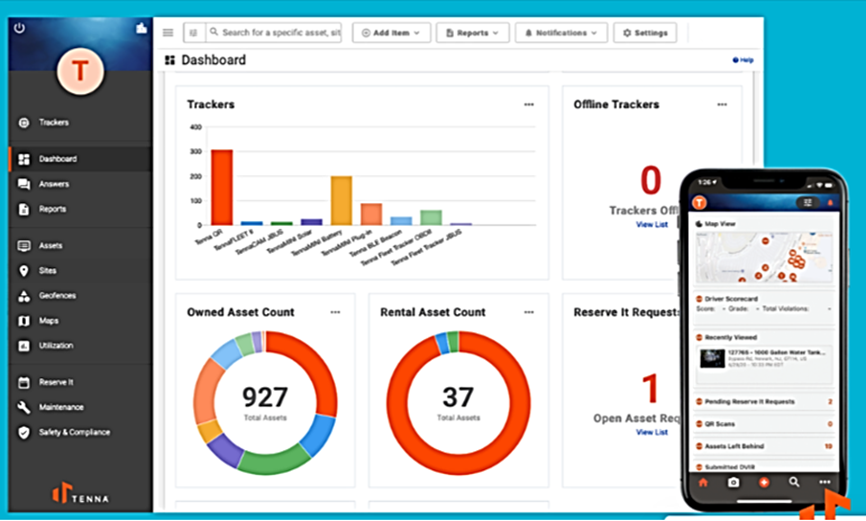
As for BLE beacons specifically, Tenna offers two types: TennaBLE Beacon and TennaBLE Beacon Steel Puck.
These beacons are designed for tracking smaller equipment, tools, and attachments when they’re in the range of mobile devices that use the Tenna App.
However, TennaBLE beacons can be screwed, bolted, glued, or tied onto assets you want tracked, whereas Steel Puck beacons are attached by welding them onto, for example, excavator buckets and other heavy equipment attachments.
You can see both of them here, with the welded-only beacon shown on the right.
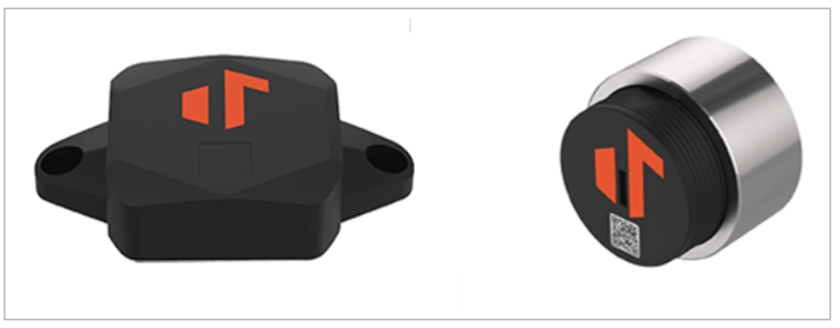
These BLE asset trackers emit regular signals that can be picked up by, for example, your on-site workers’ smartphones with the Tenna App installed and Bluetooth turned on.
This turns their mobile devices into moving signal receivers that collect beacon proximity data as workers move around the site.
To sum up, Tenna’s BLE beacons are part of Tenna’s customized asset-tracking solutions that enable companies to efficiently track and manage any type of construction assets.
Titan GPS’ Bluetooth Beacons
As its name suggests, Titan GPS is another cloud-based construction fleet management solution focused on active GPS tracking.
As such, Bluetooth beacons are only one feature of this fleet tracking system.
More precisely, BLE beacons attached to different assets must be detected by Titan GPS trackers, TT6000, installed on vehicles and heavy equipment.
To quote Titan GPS:
When an equipped vehicle is in range of a Bluetooth Beacon, the system collects the Beacon ID and sends it to Titan GPS by pinging the nearest cell tower or satellite.
This means that, for the beacon-based tracking system to work, the TT6000 needs to be connected to a vehicle that powers it.
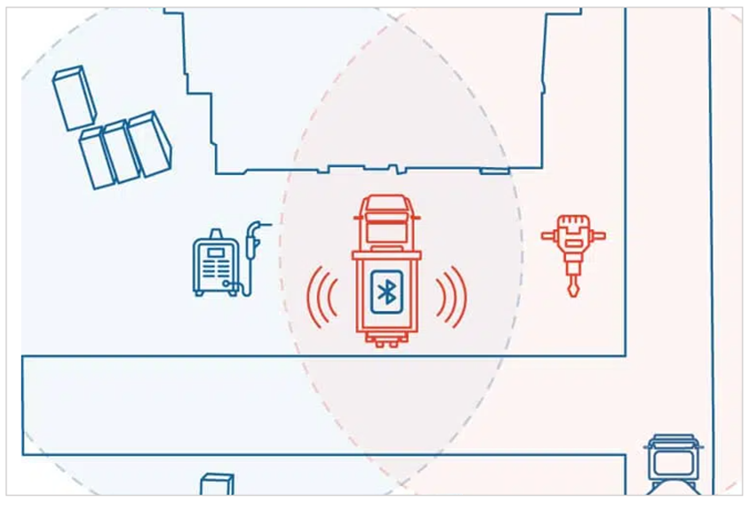
Therefore, as vehicles and heavy machinery move across the site, their GPS trackers will detect and record beacon signals in the Titan GPS app.
From there, the Titan GPS app will create a map of asset locations, whereas the time when that location was last recorded will depend on when the asset last entered the range of a GPS tracker-equipped vehicle or heavy equipment.
All in all, Titan GPS is a comprehensive fleet management solution that can effectively utilize Bluetooth beacons to expand its tracking abilities to smaller construction equipment, tools, and other assets.
Conclusion
Having covered seven top providers of construction asset-tracking solutions involving Bluetooth beacons, it’s evident that beacons can be used as an effective and cost-efficient tracking method.
Alone or combined with other tracking technologies, such as higher-priced GPS trackers or lower-priced GPS-enabled QR codes, BLE beacons enable construction companies to achieve real-time visibility of their assets, minimize asset theft or loss, and increase overall productivity.

